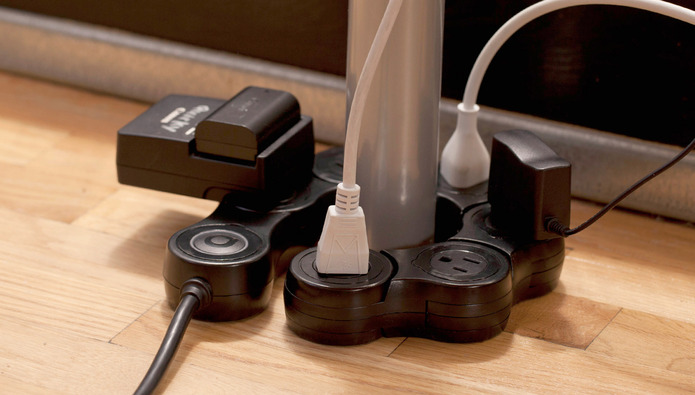Firstly, this hindrance is not true of all adapters. Transformer-based adapters take up space because they contain a large transformer. Switching supplies can be fit into a much smaller space. For instance look at the current crop of cell phone chargers.
Secondly, even transformer adapters are small enough that they can be plugged into a two-socket outlet along side with another appliance or another such adapter. Where they become a hindrance is power bars. This is due to the arguably bad design of a power bar, which stacks the outlets vertically, without space in between, failing to anticipate that users have numerous adapters.
The fix is to design a power bar whose outlets are on a 90 degree angle and have surrounding space.
Look at this power bar. It has an outlet with extra space around it which accommodates one wall-wart, and the outlets are at 90 degrees:

The transformer-based wall-wart shown is more than a decade old, yet compact. Two of them could fit into two-socket outlet, and this is by deliberate design. In other words, the engineers took steps to ensure quite the opposite of what you're suggesting, by placing the prongs close to the edge of the box.
Of course, you cannot place N of these warts into a conventional N socket power bar. This is simply not possible due to the size of the transformer.
Also shown in the picture is a modern cell phone power adapter, which is not much larger than a passive plug. Its power handling is about the same as that of the other adapter.
Now here is one more shot, which contrasts two transformer-based adapters. The large one is late 1980's Yamaha unit. It has to be that way because it's robust. This thing runs quite hot, and still works after 25 years of use.
The small wall-wart is also transformer-based (I believe) rather than switching, and shows you that these things can get down to size. However, it is only rated for 200 mA at 9V. A switching supply in that size can deliver a lot more current.
Large as it is, the Yamaha one can still be plugged into a two-socket wall outlet, while that outlet accommodates another appliance. Again, it's designed for minimum hindrance, while providing the necessary space for the transformer and ventilation around it. Note how the tiny wart, and the big one, both have just about exactly the same clearance between the prongs and the closest edge.

Here are two of these power supplies easily plugged into the same outlet, with half an inch of clearance in between!

So basically, your premise that engineers deliberately design adapters to hinder other devices from being plugged in is wrong; you just have to think about your adapters when you're shopping for a power bar.












